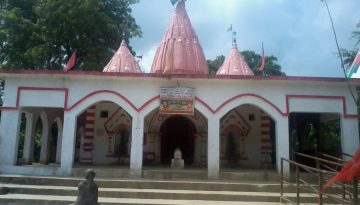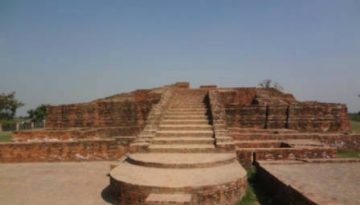Places to visit in Shravasti District
Places to visit in Shravasti District
Vibhuti Nath Temple
The district Shravasti with headquarter Bhinga is situated in the northern zone of Uttar Pradesh in Himalayan range, adjacent to Nepal border. During  Mahabharata period, Pandava spend twelve years in exile and one year concealed place. At the period exile they resides sometimes in this forest region called Sohalva. At that time Bhima initiated to formed a village, so the name of village was known as Bhimgaon, later on it became BHINGA. In Himalayan range, 36 Km north form Bhimgaon, Pandva laid foundation a Shiva temple which is famous as Vibuthi nath. Thousands of devotee visit the temple every year. During “Sawan” millions of devotee visits the temple for offering their prayer to lord Shiva.
Mahabharata period, Pandava spend twelve years in exile and one year concealed place. At the period exile they resides sometimes in this forest region called Sohalva. At that time Bhima initiated to formed a village, so the name of village was known as Bhimgaon, later on it became BHINGA. In Himalayan range, 36 Km north form Bhimgaon, Pandva laid foundation a Shiva temple which is famous as Vibuthi nath. Thousands of devotee visit the temple every year. During “Sawan” millions of devotee visits the temple for offering their prayer to lord Shiva.
Suhaildev Wildlife Sanctuary
Suhaildev Wild Life Sanctuary, in the district of Balrampur and Shravasti, close to the Indo-Nepal border, is spread over an area of 452 sq.kms. With a buffer zone of 220 sq.kms the Suhaildev Wild Life Sanctuary was established in 1988. Situated on the International Border ,this sanctuary is a strip of land ,  approximately, 120kms long from the east to west and 6-8 kms wide. In the north are the jungles of Nepal and together they form a situational unit. The wild life sanctuary encompasses Tulsipur, Barhawa, Bankatwa, Eastern Suhailwa and Western Suhailwa Range and the Buffer Zone covers Bhaabar and Rampur Range. These natural forests have a vast natural wealth and bio-diversity.
approximately, 120kms long from the east to west and 6-8 kms wide. In the north are the jungles of Nepal and together they form a situational unit. The wild life sanctuary encompasses Tulsipur, Barhawa, Bankatwa, Eastern Suhailwa and Western Suhailwa Range and the Buffer Zone covers Bhaabar and Rampur Range. These natural forests have a vast natural wealth and bio-diversity.
The Suhaildev Wild Life Sanctuary is situated near an important Buddhist circuit and a number of foreign Buddhist tourists visit Shravasti, an important Buddhist holy place on the southern border of the sanctuary. It is from Shravasti that the Buddhist tourists move on to the other holy places on the circuit ,viz, Kapilvastu, Lumbini and Kushinagar.
Before the implementation of the Zamindari Abolition Act 1952, most of the forest land of the sanctuary was the personal property of the Maharaja of Balrampur and the area was known as Balrampur Estate. Later after the abolition of Zamindari, the forests were assimilated in to the state of U.P.
Another unique feature of the sanctuary is the presence of the Tharu Tribe. The Tharu tribe having mongoloid features have been residents of this area since long and are wholly dependent on the forest land for their survival and livelihood.
Vegetation Primarily Sheesham, Khair, etc are commonly found. Jaamun Trees. Jigna, Haldu, Faldu plants etc can also be seen. Medicinal plants also have their fair share in the forest area.
Wild Animals Tigers, Leopard, Cheetal, Bear, Wolfe, Hare, Jackal, Wild Boar, Sambar, Mankey, Langoor, Python ,Otters etc can be commonly sighted. A number of birds like Black Partridge, Quails, Peacocks, Kingfishers, Bulbuls, Mynahs, Eagles, Nightingales, Cuckoo, and Owls etc also inhabit the forest area.
Large water bodies /reservoirs like Chittorgarh, Kohargaddi, Bhagwanpur, Girgitha, Khairmaan and Raziataal dot the sanctuary area. These water-bodies attract a large number of local and migratory birds. Of all the water bodies in the sanctuary, Chittorgarh, Bhagwanpur and Raziataal offer a more scenic and enthralling experience.
Kacchi Kuti
Kacchi Kuti is one of the significant excavated structures situated inside Mahet and is among the two mounds located in the Mahet area. Kachchi Kuti is situated  few mts. ahead & in south-east direction of Pakki Kuti. Inscriptions, found on the lower portion of an image of Bodhisatva excavated from this site, reveal that this structure dates back to Kushana Period. Evidences show that this site has been renovated several times subsequently. The site has been considered to be associated with the Brahmanical temple by some scholars while another group of scholars quoting some Chinese pilgrims Fa-hien & Hiuen Tsang associate this site with the Stupa of Sudatta (Anathpindika).
few mts. ahead & in south-east direction of Pakki Kuti. Inscriptions, found on the lower portion of an image of Bodhisatva excavated from this site, reveal that this structure dates back to Kushana Period. Evidences show that this site has been renovated several times subsequently. The site has been considered to be associated with the Brahmanical temple by some scholars while another group of scholars quoting some Chinese pilgrims Fa-hien & Hiuen Tsang associate this site with the Stupa of Sudatta (Anathpindika).
It represents structural remains of different periods beginning from 2nd century AD to 12th century AD. The different strata of the structure makes it very complicated to understand its identification. On the basis of a large number of antiquities recovered from the site and nature of exposed structures, there appears to be a superimposition of a shrine belonging to Gupta Period over a Buddhist stupa of Kushana Period. The pathway connects this structure with city gate known as Naushahra & Kandbhari gates.
Pakki Kuti
Pakki Kuti is one of the largest mounds found in Mahet area. It has been identified as remains of stupa of Angulimala as referred by famous Chinese traveller Fa- hien & Hiuen Tsang & also by Cunningham while some other scholars relate it to the ruins of ‘Hall of Law’, supposed to have been built by Prasenjit in honour of Lord Buddha. The structure has undergone a number of subsequent alterations and additions. It appears to be a terraced stupa built on rectangular plan. The supports and drains were provided to the structure as a preventive measure during the time of excavation. The general layout of the structural remains represents constructional activities of different periods, of which earliest may be assigned to Kushana Period.
hien & Hiuen Tsang & also by Cunningham while some other scholars relate it to the ruins of ‘Hall of Law’, supposed to have been built by Prasenjit in honour of Lord Buddha. The structure has undergone a number of subsequent alterations and additions. It appears to be a terraced stupa built on rectangular plan. The supports and drains were provided to the structure as a preventive measure during the time of excavation. The general layout of the structural remains represents constructional activities of different periods, of which earliest may be assigned to Kushana Period.
Vipassana Meditation Centre
This meditation centre is situated right on State Highway 26, opposite Buddha Inter College, barely a few minutes walk from the Jetavana Archaeological Park.  As Jetavana is the place where the Buddha spent more time than anywhere else (24 rain retreats), this centre is highly recommended for those who wish to learn meditation, as well as the experienced meditators.
As Jetavana is the place where the Buddha spent more time than anywhere else (24 rain retreats), this centre is highly recommended for those who wish to learn meditation, as well as the experienced meditators.
Source :
Last Modified : 4/9/2024
